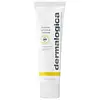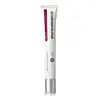What's inside
What's inside
 Key Ingredients
Key Ingredients

 Benefits
Benefits

 Concerns
Concerns

 Ingredients Side-by-side
Ingredients Side-by-side

Water
Skin ConditioningZinc Oxide
Cosmetic ColorantCaprylic/Capric Triglyceride
MaskingC12-15 Alkyl Benzoate
AntimicrobialDimethicone
EmollientButyloctyl Salicylate
Skin ConditioningButylene Glycol
HumectantGlycerin
HumectantSilica
AbrasivePolyhydroxystearic Acid
EmulsifyingPEG-10 Dimethicone
Skin ConditioningArgania Spinosa Kernel Oil
EmollientCordyceps Sinensis Extract
AntioxidantTrametes Versicolor Extract
Sodium Hyaluronate
HumectantCamellia Sinensis Leaf Extract
AntimicrobialEucalyptus Globulus Leaf Oil
PerfumingLavandula Spica Flower Oil
MaskingTocopheryl Acetate
AntioxidantSodium Chloride
MaskingStearalkonium Hectorite
Gel FormingPentylene Glycol
Skin ConditioningLauryl PEG-9 Polydimethylsiloxyethyl Dimethicone
Skin ConditioningPropanediol
SolventDimethicone Crosspolymer
Emulsion StabilisingSodium Citrate
BufferingPropylene Carbonate
SolventXanthan Gum
EmulsifyingCaprylyl Glycol
EmollientBisabolol
MaskingLavandula Hybrida Oil
EmollientEthylhexylglycerin
Skin ConditioningSodium Hydroxide
BufferingPotassium Sorbate
PreservativeSodium Benzoate
MaskingLinalool
PerfumingLimonene
PerfumingWater, Zinc Oxide, Caprylic/Capric Triglyceride, C12-15 Alkyl Benzoate, Dimethicone, Butyloctyl Salicylate, Butylene Glycol, Glycerin, Silica, Polyhydroxystearic Acid, PEG-10 Dimethicone, Argania Spinosa Kernel Oil, Cordyceps Sinensis Extract, Trametes Versicolor Extract, Sodium Hyaluronate, Camellia Sinensis Leaf Extract, Eucalyptus Globulus Leaf Oil, Lavandula Spica Flower Oil, Tocopheryl Acetate, Sodium Chloride, Stearalkonium Hectorite, Pentylene Glycol, Lauryl PEG-9 Polydimethylsiloxyethyl Dimethicone, Propanediol, Dimethicone Crosspolymer, Sodium Citrate, Propylene Carbonate, Xanthan Gum, Caprylyl Glycol, Bisabolol, Lavandula Hybrida Oil, Ethylhexylglycerin, Sodium Hydroxide, Potassium Sorbate, Sodium Benzoate, Linalool, Limonene
Titanium Dioxide 4%
Cosmetic ColorantZinc Oxide 14%
Cosmetic ColorantCyclopentasiloxane
EmollientCaprylic/Capric Triglyceride
MaskingDimethicone Crosspolymer
Emulsion StabilisingDiisopropyl Adipate
EmollientVinyl Dimethicone/Methicone Silsesquioxane Crosspolymer
Silica
AbrasiveLauryl PEG-9 Polydimethylsiloxyethyl Dimethicone
Skin ConditioningPolyglyceryl-3 Polydimethylsiloxyethyl Dimethicone
Skin ConditioningWater
Skin ConditioningArginine/Lysine Polypeptide
Skin ConditioningCamellia Sinensis Leaf Extract
AntimicrobialPalmitoyl Dipeptide-5 Diaminobutyroyl Hydroxythreonine
Skin ConditioningPalmitoyl Dipeptide-5 Diaminohydroxybutyrate
Skin ConditioningSodium Hyaluronate
HumectantHydrolyzed Soy Protein
HumectantSilanetriol
Hydrolyzed Pearl
Skin ConditioningLavandula Spica Flower Oil
MaskingLavandula Hybrida Oil
EmollientEucalyptus Globulus Leaf Oil
PerfumingSodium PCA
HumectantPolyhydroxystearic Acid
EmulsifyingTriethoxycaprylylsilane
Stearic Acid
CleansingAluminum Hydroxide
EmollientPEG/PPG-18/18 Dimethicone
EmulsifyingPEG/PPG-20/15 Dimethicone
EmulsifyingGlycerin
HumectantPhenoxyethanol
PreservativeEthylhexylglycerin
Skin ConditioningTin Oxide
AbrasiveCI 77491
Cosmetic ColorantCI 77492
Cosmetic ColorantCI 77499
Cosmetic ColorantTitanium Dioxide 4%, Zinc Oxide 14%, Cyclopentasiloxane, Caprylic/Capric Triglyceride, Dimethicone Crosspolymer, Diisopropyl Adipate, Vinyl Dimethicone/Methicone Silsesquioxane Crosspolymer, Silica, Lauryl PEG-9 Polydimethylsiloxyethyl Dimethicone, Polyglyceryl-3 Polydimethylsiloxyethyl Dimethicone, Water, Arginine/Lysine Polypeptide, Camellia Sinensis Leaf Extract, Palmitoyl Dipeptide-5 Diaminobutyroyl Hydroxythreonine, Palmitoyl Dipeptide-5 Diaminohydroxybutyrate, Sodium Hyaluronate, Hydrolyzed Soy Protein, Silanetriol, Hydrolyzed Pearl, Lavandula Spica Flower Oil, Lavandula Hybrida Oil, Eucalyptus Globulus Leaf Oil, Sodium PCA, Polyhydroxystearic Acid, Triethoxycaprylylsilane, Stearic Acid, Aluminum Hydroxide, PEG/PPG-18/18 Dimethicone, PEG/PPG-20/15 Dimethicone, Glycerin, Phenoxyethanol, Ethylhexylglycerin, Tin Oxide, CI 77491, CI 77492, CI 77499
 Reviews
Reviews

Ingredients Explained
These ingredients are found in both products.
Ingredients higher up in an ingredient list are typically present in a larger amount.
Camellia Sinensis Leaf Extract is derived from the leaves of the tea plant. Black tea, green tea, and oolong tea are all harvested from this plant.
This ingredient has many skin benefits:
This ingredient contains polyphenols, a strong antioxidant. Antioxidants help fight off molecules that damage skin cells.
On top of that, the antioxidants in green tea neutralize free-radicals from the sun. This gives the skin some extra UV protection, but should not replace sunscreen.
Many components of tea have anti-inflammatory properties.
Polyphenols and L-theanine help soothe the skin and reduce irritation. The caffeine in Camellia Sinensis Leaf Extract helps calm inflamed blood vessels.
Other compounds found in tea include: Vitamin Bs, linoleic acid, magnesium, calcium, iron, and zinc.
Research has shown both drinking Camellia Sinensis Leaf Tea and applying it to the skin can help boost skin elasticity and hydration. Studies also show using tea extract may reduce sebum, or oil, production.
Learn more about Camellia Sinensis Leaf ExtractThis ingredient is an emollient, solvent, and texture enhancer. It is considered a skin-softener by helping the skin prevent moisture loss.
It helps thicken a product's formula and makes it easier to spread by dissolving clumping compounds.
Caprylic Triglyceride is made by combining glycerin with coconut oil, forming a clear liquid.
While there is an assumption Caprylic Triglyceride can clog pores due to it being derived from coconut oil, there is no research supporting this.
Learn more about Caprylic/Capric TriglycerideDimethicone Crosspolymer is a silicone created by modifying dimethicone with hydrocarbon side chains. Due to its large size, it does not penetrate skin. It is considered non-occlusive.
Dimethicone Crosspolymer is used to stabilize and thicken products. It also helps give products a silky feel.
Ethylhexylglycerin (we can't pronounce this either) is commonly used as a preservative and skin softener. It is derived from glyceryl.
You might see Ethylhexylglycerin often paired with other preservatives such as phenoxyethanol. Ethylhexylglycerin has been found to increase the effectiveness of these other preservatives.
This oil is derived from the leaves of Eucalyptus Globulus, a type of Eucalyptus tree native to Australia.
Though this oil shows antibacterial and antioxidant activity, it is also a known skin-irritant due to its fragrance components.
Glycerin is already naturally found in your skin. It helps moisturize and protect your skin.
A study from 2016 found glycerin to be more effective as a humectant than AHAs and hyaluronic acid.
As a humectant, it helps the skin stay hydrated by pulling moisture to your skin. The low molecular weight of glycerin allows it to pull moisture into the deeper layers of your skin.
Hydrated skin improves your skin barrier; Your skin barrier helps protect against irritants and bacteria.
Glycerin has also been found to have antimicrobial and antiviral properties. Due to these properties, glycerin is often used in wound and burn treatments.
In cosmetics, glycerin is usually derived from plants such as soybean or palm. However, it can also be sourced from animals, such as tallow or animal fat.
This ingredient is organic, colorless, odorless, and non-toxic.
Glycerin is the name for this ingredient in American English. British English uses Glycerol/Glycerine.
Learn more about GlycerinLauryl PEG-9 Polydimethylsiloxyethyl Dimethicone is a type of silicone.
Lavandula Hybrida Oil is an oil.
Lavandula Spica Flower Oil is an oil.
Polyhydroxystearic Acid is a soft wax made from castor oil.
It is is a texture thickener, emulsifier, and film-former. Emulsifiers prevent ingredients from separating, such as oils and waters.
Polyhydroxystearic Acid may not be fungal acne safe.
Learn more about Polyhydroxystearic AcidSilica, also known as silicon dioxide, is a naturally occurring mineral. It is used as a fine, spherical, and porous powder in cosmetics.
Though it has exfoliant properties, the function of silica varies depending on the product.
The unique structure of silica enhances the spreadability and adds smoothness, making it a great texture enhancer.
It is also used as an active carrier, emulsifier, and mattifier due to its ability to absorb excess oil.
In some products, tiny microneedles called spicules are made from silica or hydrolyzed sponge. When you rub them in, they lightly polish away dead skin layers and enhance the penetration of active ingredients.
Learn more about SilicaSodium Hyaluronate is hyaluronic acid's salt form. It is commonly derived from the sodium salt of hyaluronic acid.
Like hyaluronic acid, it is great at holding water and acts as a humectant. This makes it a great skin hydrating ingredient.
Sodium Hyaluronate is naturally occurring in our bodies and is mostly found in eye fluid and joints.
These are some other common types of Hyaluronic Acid:
Learn more about Sodium HyaluronateWater. It's the most common cosmetic ingredient of all. You'll usually see it at the top of ingredient lists, meaning that it makes up the largest part of the product.
So why is it so popular? Water most often acts as a solvent - this means that it helps dissolve other ingredients into the formulation.
You'll also recognize water as that liquid we all need to stay alive. If you see this, drink a glass of water. Stay hydrated!
Learn more about WaterZinc Oxide is a mineral broad-spectrum UV filter; it is the broadest UVA and UVB reflector approved by the FDA. It also has skin protectant and skin soothing properties.
Zinc oxide is one of the most effective broad-spectrum UV filters. It protects against UVB, UVAII, and UVAI. In comparison to its counterpart titanium dioxide, zinc oxide provides uniform and extended UVA protection.
Another great benefit? This ingredient is highly photostable so it won't degrade easily under sunlight.
A common myth is that mineral UV filters are widely believed to primarily reflect UV light.
However, modern research shows titanium dioxide absorbs UV radiation like chemical filters (~95% absorption & 5% reflection).
Zinc oxide has great skin soothing properties so you'll likely find this in sunscreens formulated for sensitive skin or babies/children. It is unlikely to cause "eye sting" like other sunscreen ingredients.
Regulatory agencies consider zinc oxide to be non-toxic and safe. It has also been shown to not penetrate the skin.
Unfortunately, this ingredient does leave a visible white cast. This is why mineral sunscreens are often less cosmetically elegant than chemical or hybrid ones.
In cosmetics, zinc oxide can be found in both non-nano and nano-sized forms. The nano version is used to reduce white cast and improve the texture of sunscreen formulas.
There are ongoing concerns surrounding nano-zinc oxide's impact on marine ecosystems and whether it can be absorbed into skin.
Regarding marine ecosystems and coral reefs, there is no conclusive evidence that any form of zinc oxide (or any other sunscreen ingredients) will cause harm. The science is still developing but many consumers are keeping a close eye on this issue.
Please note, many destinations have reef-safety sunscreen rules. For instance, the U.S. Virgin Islands advises all visitors to use non-nano mineral sunscreens.
There has also been some stir about whether micronized or nano zinc oxide has potential photoxicity and absorption through the skin/lungs.
An in-vitro (done in a test tube or petri dish) study demonstrated micronized zinc oxide to have potential phototoxicity. There's no need to fret; the EU Commission's Scientific Committee on Consumer Safety has stated, "The relevance of these findings needs to be clarified by appropriate investigations in vivo." Or in other words, further studies done on living organisms are needed to prove this.
Current research shows zinc oxide nanoparticles do not penetrate intact or sunburned skin. They either remain on the surface or in the outermost layer of dead skin (stratum corneum).
Zinc oxide is one of only two classified mineral UV filters with titanium dioxide being the other one.
Fun fact: Zinc has been used throughout history as an ingredient in paint and medicine. An Indian text from 500BC is believed to list zinc oxide as a salve for open wound. The Ancient Greek physician Dioscorides has also mentioned the use of zinc as an ointment in 1AD.
Learn more about Zinc Oxide